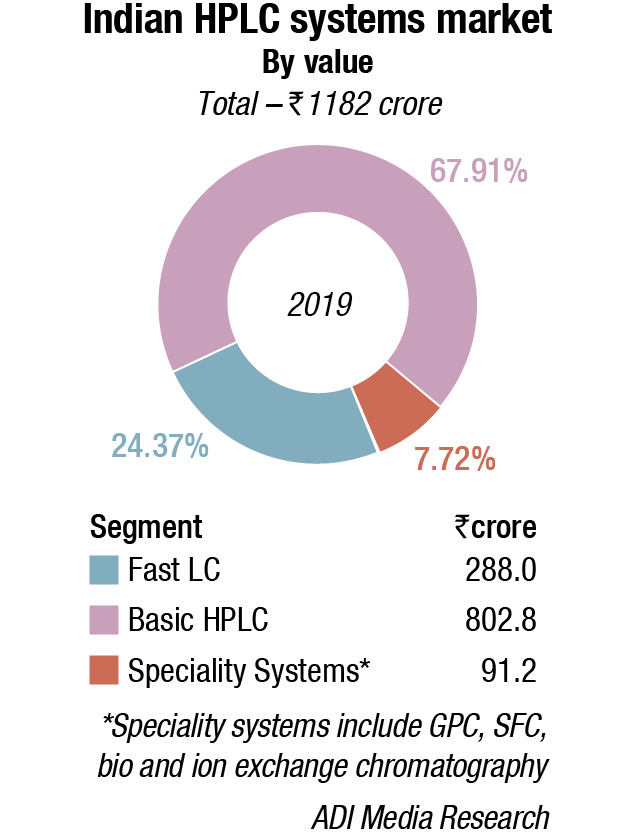HPLC Systems
Shaping the future of liquid-phase separation science
Recent HPLC advances are helping analytical testing laboratories achieve optimal productivity.
 In recent years, in addition to the essential activities around the optimization of technologies and instrumentation used for analysis, every area of the analytical laboratory has needed to adopt modern management and productivity processes. Methods are increasingly developed using QbD (Quality by Design) principles and are subject to active lifecycle management; and most of the instrumentation in the lab – from high-end high performance liquid chromatography mass spectrometry (HPLC-MS) systems down to more humble centrifuges, balances and pumps – are integrated into control software and lab management tools. The goals: repeatable/certifiable performance, maximum efficiency and cost-effective operation, along with improved environmental awareness.
In recent years, in addition to the essential activities around the optimization of technologies and instrumentation used for analysis, every area of the analytical laboratory has needed to adopt modern management and productivity processes. Methods are increasingly developed using QbD (Quality by Design) principles and are subject to active lifecycle management; and most of the instrumentation in the lab – from high-end high performance liquid chromatography mass spectrometry (HPLC-MS) systems down to more humble centrifuges, balances and pumps – are integrated into control software and lab management tools. The goals: repeatable/certifiable performance, maximum efficiency and cost-effective operation, along with improved environmental awareness.
Achieve optimal productivity
Routine analysis laboratories play a vital role in safeguarding integrity across a wide range of sectors, from food and beverage to forensic and pharmaceutical. With product safety and reliable decision-making on the line, these laboratories must balance productivity with the highest standards of analytical accuracy. Yet, for laboratories operating at or near capacity, or planning to grow their market share, scaling-up workflows without compromising on quality can be challenging.
Some common productivity challenges in routine LC analysis workflows. Routine analysis laboratories may face several potential productivity challenges with regards to their LC workflows. One of the most common sources of inefficiency is the process of transferring LC methods between instruments, where unforeseen complications and delays can divert time away from testing and have a major impact on productivity. This is true not only when transferring methods between laboratories, such as from analytical development to quality control (QC) settings, or when outsourcing to contract laboratories, but also when scaling-up methods across multiple instruments within the same laboratory or transferring workflows from legacy to new systems.
The ease and speed of method transfer often depends upon several factors, including the robustness of the method to be transferred, as well as the instrumental deviations of the systems involved. Here, the technical characteristics of the platform, such as gradient delay volume, pump mixing mode, hydrodynamic behavior, choice of column and eluent thermostatic options, can all affect critical performance outcomes, such as peak resolution or retention times. The complexity of method transfer is also determined in large part by the requirements of the analytical outcome and defined limits of acceptable deviation from the original system. Ideally, method transfer should occur with no method modifications to avoid spending large amounts of time and resources re-validating methods.
 Dr Shaloo Kapoor
Dr Shaloo Kapoor
Chief Pathologist & Sr. DGM, Fortis Escorts Heart Institute
“High-performance or high-pressure liquid chromatography (HPLC) is an automated, highly reproducible, rapid, efficient, and advanced column chromatographic method. It is used to identify and quantify analytes or components from mixture. Recent advances include UHPLC (ultra high pressure) and droplet based microfluidics or chiral NP-chip-HPLC column; lab on chip. Innovations are likely to increase throughput, gain more confidence in results and drive down cost per sample.”
Other important causes of low productivity often stem from small yet critical oversights during routine laboratory processes, which can have major consequences for operational success. For example, poorly-maintained eluent levels will cause sequences to stop mid-run if there is insufficient solvent to complete an analytical sequence, resulting in the loss of samples, sample re-analysis, and if working in a regulated environment, documentation for regulatory authorities. Compromised HPLC systems are also a key source of laboratory inefficiency, leading to unreliable and out-of-specification results that take valuable time out of routine workflows and prevent laboratories from achieving optimal productivity. Equally, recognizing these performance issues too late can result in extended instrument downtime due to unscheduled maintenance.
Overcoming challenges. With productivity now a key focus point for analysis laboratories across all sectors, instrument vendors have responded by developing HPLC technologies designed to overcome these challenges.
One of the main reasons why method transfer can be so time-consuming is that success is often not defined by a single instrumental parameter: factors such as gradient delay volumes, column thermostatting, and system dispersion effects all play important roles.
Poor system configurability through rigid instrument design can, therefore, be a major stumbling block. Fortunately, recent years have seen a heightened focus on increasingly flexible HPLC technologies that can help laboratories streamline method transfer through the application of highly customizable parameters.
Some modern instruments now offer a wide range of customizable features to facilitate the precise replication of existing methods. Highly flexible platforms allow gradient delay volumes to be seamlessly adjusted to match the analyte retention time and separation profiles of other instruments. Other innovations, such as a choice of still-air and forced-air thermostatting techniques within the same instrument, can help analysts more easily mimic legacy HPLC systems to achieve the desired results faster.
Another key issue associated with method transfer relates to system dispersion effects. While lower system dispersion benefits overall separation power, it can lead to undesirable peak shapes when samples with high organic content are injected. Flexible systems that use custom injection programs to perform in-needle dilutions have enabled analysts to inject high organic samples, while maintaining exceptional chromatographic efficiency. As such, custom injection programs are increasingly seen as a powerful tool when it comes to rapidly transferring methods between systems.
Innovative productivity tools are also being built into instruments themselves. These simple yet effective features are designed to ensure instruments never run dry and waste will not run over, enabling laboratories to minimize the potential for human error, avoid lost time and, ultimately, run large sample sets with confidence.
Outlook
As workloads increase and businesses look to expand, analytical laboratories across multiple sectors are turning to the latest LC technologies to drive improvements in productivity. Thanks to modern LC solutions, forward-thinking laboratories are streamlining the movement of both analysts and samples to achieve substantial gains in capacity and efficiency.












